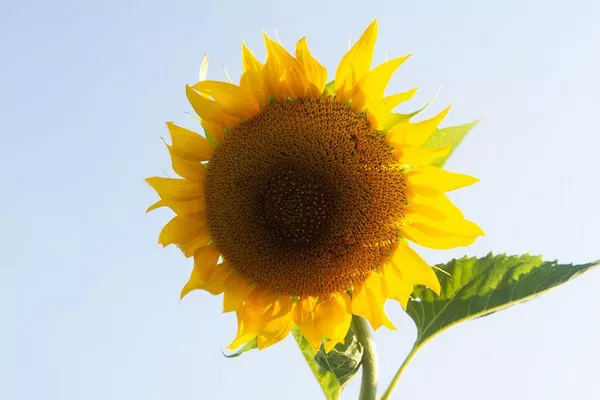Sunflowers, with their bright yellow blooms and towering stems, are iconic symbols of warmth and vitality. These vibrant flowers have captured the hearts of many with their cheerful appearance, but have you ever wondered where sunflowers come from?
The Wild Beginnings of Sunflowers
To uncover the origins of sunflowers, we must first turn our attention to the wild predecessors of the sunflowers we admire today. The genus Helianthus, to which sunflowers belong, is native to North and Central America. The wild sunflowers found their home in regions stretching from present-day Southwestern Canada down to Mexico, where they grew abundantly. These wild ancestors had smaller, more modest blooms compared to their cultivated counterparts.
The Domestication of Sunflowers
The domestication of sunflowers began thousands of years ago, with indigenous peoples in the Americas playing a crucial role in transforming wild sunflowers into the varieties we know today. Early Native American tribes recognized the sunflower’s utility and nutritional value, selectively breeding them for desirable traits.
Sunflowers in Native American Cultures
Native American cultures have a deep-rooted history of cultivating and using sunflowers. The seeds were not only a nutritious food source but also held cultural and spiritual significance. Some tribes used sunflowers in rituals and ceremonies, while others employed them for their healing properties.
Spanish Exploration and Spread to Europe
Sunflowers remained relatively unknown to the wider world until the Spanish explorers arrived in the Americas in the 16th century. They brought sunflower seeds back to Europe, introducing them to the European continent. Sunflowers soon gained popularity in European gardens for their striking appearance and adaptability to various climates.
Linnaean Classification
It was the renowned Swedish botanist Carl Linnaeus who classified sunflowers scientifically in the 18th century. He named the sunflower Helianthus annuus, drawing inspiration from the Greek words “helios” for sun and “anthos” for flower. This name aptly reflects the sunflower’s characteristic habit of following the sun throughout the day.
Russian Adoption and Innovation
One of the most remarkable chapters in the history of sunflowers is their journey to Russia. In the late 18th century, Russian farmers began to cultivate sunflowers for their oil-rich seeds. They selectively bred sunflowers to enhance their oil production, leading to the development of the Russian sunflower variety, which is still prominent today.
Sunflower Farming in the United States
Sunflowers found their way to North America in the late 18th century when they were introduced as a garden plant. However, it wasn’t until the 19th century that sunflowers began to be cultivated for their seeds and oil on a larger scale in the United States. The widespread adaptation of sunflower farming marked the beginning of their economic significance in the country.
Sunflowers in Art and Culture
Throughout history, sunflowers have been celebrated and immortalized in various forms of art and culture. Vincent van Gogh’s famous series of sunflower paintings is a testament to the flower’s cultural impact. Sunflowers have also been referenced in literature, music, and folklore as symbols of positivity, warmth, and growth.
Sunflower Varieties and Hybrids
Over the years, numerous sunflower varieties and hybrids have been developed, catering to different purposes and preferences. From the towering Giant Sunflowers to the petite Dwarf Sunflowers, and from the classic yellow blooms to the more exotic red and orange varieties, the diversity of sunflowers continues to captivate enthusiasts and gardeners alike.
The Importance of Sunflowers Today
In contemporary times, sunflowers continue to hold significance in various aspects of human life. Beyond their aesthetic appeal and use in ornamental gardens, sunflowers remain a valuable source of nutrition, as their seeds are rich in essential nutrients and healthy fats. Additionally, sunflower oil is a popular choice in cooking and cosmetics.
Sunflower Cultivation and Production
Today, sunflower cultivation is a thriving industry in many countries. The United States, Russia, Ukraine, and Argentina are some of the leading producers of sunflowers, supplying not only seeds for food but also oil for various applications. The versatility of sunflowers makes them a valuable crop in agriculture.
The Sunflower Life Cycle
Understanding the life cycle of sunflowers is essential for successful cultivation. Sunflowers are annual plants, which means they complete their life cycle in one growing season. They go through stages, from seed germination to flowering and seed production, before reaching the end of their life cycle.
Environmental Significance
Sunflowers play a role in the environment beyond their visual appeal and economic value. They are known for their phytoremediation abilities, meaning they can absorb and detoxify contaminants from the soil. Sunflowers are used in some areas to mitigate soil pollution.
Sunflowers in Conservation
The conservation of wild sunflower species and genetic diversity is crucial for maintaining the plant’s resilience. Several organizations and institutions are dedicated to preserving and studying sunflowers’ genetic heritage to ensure their long-term survival.
The Future of Sunflowers
As we look to the future, sunflowers continue to inspire and captivate with their enduring charm. The sunflower industry is evolving with advancements in agriculture and technology, aiming to meet the growing demand for sunflower products while minimizing environmental impact.
Conclusion
The journey of sunflowers from their wild origins in the Americas to their widespread cultivation and cultural significance around the world is a testament to the enduring appeal of these remarkable flowers. Their history, from early domestication by Native Americans to their adoption in Europe and Russia, is a tale of adaptation and innovation. Sunflowers are not just beautiful blooms but also important sources of nutrition, oil, and environmental benefits. Their enduring presence in art, culture, and agriculture showcases their ability to adapt and thrive in a changing world. Sunflowers are a living testament to the connections between nature, culture, and the human experience. So, the next time you gaze upon a sunflower, you’ll appreciate not only its vibrant beauty but also the rich history that brought it into existence.


